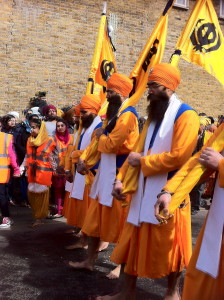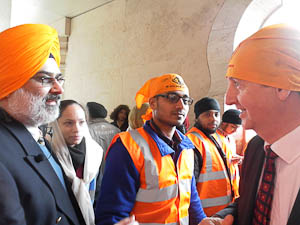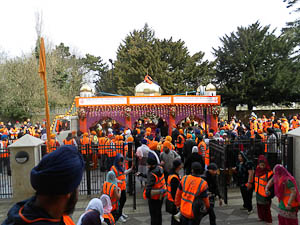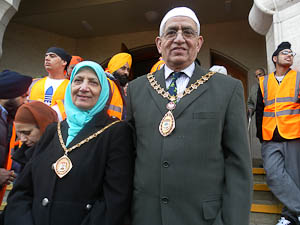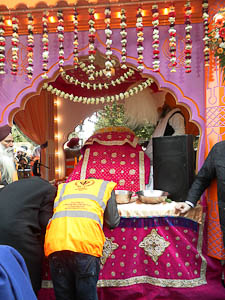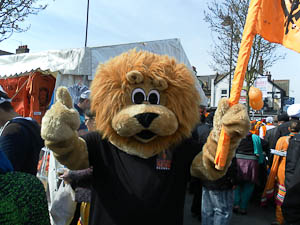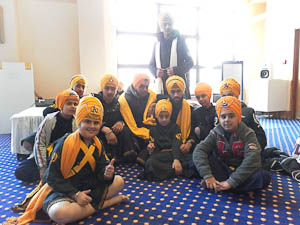Meena Toor explains what it was all about
|
Walking down King Street’s now quiet and deserted pavement, you would never have guessed that a few hours previous, Southall played host to a major community procession. Vaisakhi was celebrated with a Nagar-Kirtan (Nagar meaning ‘town’, and Kirtan is ‘praiseful chanting’) and it drew approximately 120,000 supporters, making it bigger in attendee numbers than the Notting hill Carnival.
The Nagar-Kirtan began at 11am from Havelock Road Gurdwara (‘temple’) – Europe’s largest Gurdwara – and finished at Park Avenue Road Gurdwara for 5pm. The procession of devotees follow the religion’s Holy Scripture, and while a six hour procession seems unusual, the vast amount of people in one place requires slow speeds to maintain order and safety.
The Holy Scripture within Sikhism is called the Guru Granth Sahib and is considered to be the living presence of God. It contains scriptures and teachings from the past Gurus and wise-men – who channelled the word of God – and therefore requires the utmost respect. Today being no different, the Guru Granth Sahib started its journey by being carried above the head of a Granthi (the reader of the Sikh scripture, and caretaker of the Gurdwara) over a purified and petal-covered pathway.
Sikhs will know that this Nagar-Kirtan is a celebration of the formation of the Khalsa (‘pure’) in 1699, the ‘official’ birth of the religion. The last of the Ten Gurus of Sikhism, Guru Gorbind Singh Ji, formed the Sikh community amid Mughal persecution and confusion among devotees. Famously, he bid Sikhs to face death by his sword for Sikhism, asking ‘Who will come with their head on their palm for the Guru?’ Five brave disciples willingly sacrifice themselves, each entering a tent where their blood was spilt, before miraculously re-emerging alive and blessed.
What began after this point was a new collective consciousness of what a Sikh should strive to achieve. The five disciples were known as the Panj Pyare (‘five loved ones’) who were first to wear the five symbolic items of Sikh faith (five K’s):
1. Kesh: uncut hair
2. Kangha: a wooden comb
3. Kara: a metal bracelet
4. Kachera: a specific style of cotton undergarments
5. Kirpan: a strapped curved dagger.
And the first to take the Amrit (‘nectar’) ceremony. This marked their commitment to live the life of a Saint in their thoughts, a Soldier in their duties, and follow a just code of conduct daily.
The Nagar-Kirtan is heavy with the idea of self-less service for the greater good (the Sikh principle of ‘Sewa’). Three volunteers – Sunjeet Singh (employee at Legoland), Karanveer Singh (solicitor) and Jasdeep Singh (first year student at Westminster University, studying Computer science) – organised the event. Likewise, donations from the community like the high-visibility jackets, pro-bono photographers and the mass of food stands from local businesses opens up the event to community participation.
Approximately 270 Sewadars (volunteers doing selfless service) committed to assisting crowds, clearing the procession route and guiding visitors; the unpaid equivalent to the Games-Makers of the Olympics. Jasdeep, leading the ‘Bridge’ team’s 40 Sewadars says that the hardest task has been getting people to come to meetings and spread the word. Recent use of Facebook has engaged the younger generation, gaining over 600 likes online and a distinct demographic presence among the Sewadars.
Jasdeep reports that volunteers can be followers of all religions, but must be over 16 to participate. Older respected members of the community can apply to represent the Panj Pyare travelling in front of the procession, either holding the Sikh flag (‘Nishan sahib’) with the symbolic Khanda, or a sword to protect the Guru Granth Sahib. ‘Whatever you do, it’s a great honour to be helping out’.
The event was opened with speeches from the Mayor of Ealing, Mohammad Aslam; Seema Malhotra, MP for Feltham and Heston and Julian Bell, Labour Leader of Ealing Council. Mayor Aslam provides a special message to the residents of Ealing attending today saying ‘today is a great day for happiness, because the community has come together. I’d like to wish the whole community a very, very happy Vaisakhi and it’s an honour to be here as the Mayor.’
Along with the significant guests, teams of Police and volunteers from St. John’s Ambulance remarked on how wonderfully colourful and cheerful the festival was. Bob Dowling, a senior volunteers with St. John’s Ambulance for 20 years, explains how ailments can cover blisters right the way to heatstroke: ‘Having the treatment centers, and the people in the crowds, gives everyone peace of mind – when it comes to injuries, whether you’re from one background or another, the need for community services like first-aid is universal and crosses all nationalities’.
Local groups were not far behind with getting involved. Gutka warriors gave a spectacular show of skill and power with special weapons. Children from the newly opened Khalsa Primary school came to be part of the procession. S.W.A.T (Sikh Welfare Awareness Team) were distributing information about their ‘help the Southall homeless’ programme.
Additionally, a small peaceful march took place in remembrance of Bhai Jaspal Singh, a student who died during a peaceful protest in Punjab on the 29th March 2012.

The President of the Havelock Road Gurdwara committee, Sardar Himmat Singh Sohi, had a final message to the community to mark the occasion:
‘We are very happy because this is the celebration of Vaisakhi and we have come together to enjoy it. We want to share a message that we are a peaceful people and want to share with the community and see the young generations come to their own ‘house’. Also, the purpose of the day is to send a message to keep continued peace and harmony in the community.’
Meena Toor
twitter @journomeena
8th April 2013
